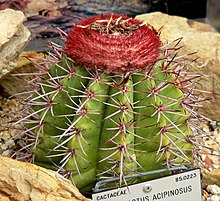Melocactus
Melocactus (melon cactus) is a genus of cactus with about 30-40 species. They are native to the Caribbean, western Mexico through Central America to northern South America, with some species along the Andes down to southern Peru, and a concentration of species in northeastern Brazil.[1]
The first species was named by Carl Linnaeus in 1753, as Cactus melocactus. When the genus was separated from Cactus, the pre-Linnaean name Melocactus was used. Acting on the principle of priority, in 1922 Nathaniel Britton and Joseph Rose resurrected Linnaeus' Cactus. However, the 1905 Vienna botanical congress had already rejected the name Cactus, so this name was not available, and Melocactus Link & Otto is the correct genus name.[1]
Mature plants are easily recognizable by their cephalium, a wool- and bristle-coated structure at the apex of the plant, containing a mass of areoles from which the small flowers grow.[1]
Since the red, wool-coated cephalium of the plant is similar to the Fez hat of the Turkish male citizens during late Ottoman Empire, one name for the plant is Turk's cap cactus.[citation needed]
References
- ^ a b c Anderson, Edward F. (2001), The Cactus Family, Pentland, Oregon: Timber Press, ISBN 978-0-88192-498-5, pages=456–467

